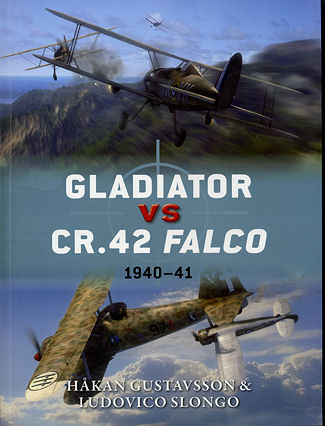 Though WWII
saw the ascendency of the low wing monoplane fighter with retractable landing
gear, many nations entered the conflict with fixed wing biplane fighters. Great
Britian and Italy were two of them. The most modern biplane in the RAF was the
Gladiator, a plane that had excellent maneuverability and also a relatively good
gun in the Browning .303, that while not packing a lot of puch, had a high rate
of fire so was able to put a lot of lead into an enemy in a relatively short
time.
Though WWII
saw the ascendency of the low wing monoplane fighter with retractable landing
gear, many nations entered the conflict with fixed wing biplane fighters. Great
Britian and Italy were two of them. The most modern biplane in the RAF was the
Gladiator, a plane that had excellent maneuverability and also a relatively good
gun in the Browning .303, that while not packing a lot of puch, had a high rate
of fire so was able to put a lot of lead into an enemy in a relatively short
time.
Italy entered the war with the CR.42, probably the most modern biplane fighter
of any of the warring powers. This aircraft was supposed to have a pair of 12.5
mm guns in the nose but a lack of these guns meant that most saw combat with but
one of these and a 7.7mm gun. While the 12.5mm gun was a powerful weapon, it had
a rather slow rate of fire, especially when it had to be geared down to fire
through the prop, something two of the Gladiator's four guns did not have to do
as they were wing mounted. Unlike the Gladiator, the CR.42 was not all that
maneuverable as biplanes went. It had a smaller overall wing area and it took a
while for Italian pilots to realize they could not dog-fight the Gladiator,
resorting to hit and run attacks. Much like Wildcats in the Pacific against the
more maneuverable A6M2.
While these planes were both quickly withdrawn from combat in
Western Europe, as they were totally outclassed by enemy monoplanes, they were
very much the workhorse in the 'secondary' war zones of East Africa, North
Africa and Greece. It was in these theaters of operation in 1940 and 1941 that
they met each other in battle a great number of times. In Greece the Gladiator
was also flown by Greek pilots, often against the CR.42. It was when the
Italians introduced the Macchi C.200 in the skies of Greece that the Gladiator
was severely outclassed. Also in North Africa this was a concern as was the
introduction of German 109s. However, before that there were plenty of
opportunities for these two types to meet in the air and both had their levels
of success against each other.
The authors take a look at the development of both types as
well as how they were used in the various areas of operations. We are provided
the technical specs of the two aircraft and are treated to a number of combat
reports from pilots flying both aircraft as to what it must have been like to
fly these planes. Both sides suffered from supply deficiencies that often kept
planes on the ground where they were frequently destroyed by incoming raids. In
the end, the assessment of the two types shows that one of them was a at an
advantage over the other. I already mentioned the greater maneuverability and
weight of fire of the Gladiator, but should also mention that the RAF and Greeks
believed in radios, something the Italians rarely carried in their Falcos. This
provided an enormous tactical advantage to the Gladiator pilots as they were
able to form up for attacks much easier. In the end, both types performed well
before being relegated to second line duties and finally removed from service
entirely.
The result is a very well done book with lots of great period
photos and some very well done art work. It is a fine addition to the series and
is a book I know you will not only enjoy reading, but will learn from it as
well.
January 2013
For more on the complete line of Osprey books,
visit www.ospreypublishing.com. In the US, it is
Osprey Direct at 443 Park Avenue South, New York, NY 10016, where you can
get a catalogue of available books.
If you would like your product reviewed fairly and quickly, please contact
the editor or see other details in the Note to
Contributors.
 Though WWII
saw the ascendency of the low wing monoplane fighter with retractable landing
gear, many nations entered the conflict with fixed wing biplane fighters. Great
Britian and Italy were two of them. The most modern biplane in the RAF was the
Gladiator, a plane that had excellent maneuverability and also a relatively good
gun in the Browning .303, that while not packing a lot of puch, had a high rate
of fire so was able to put a lot of lead into an enemy in a relatively short
time.
Though WWII
saw the ascendency of the low wing monoplane fighter with retractable landing
gear, many nations entered the conflict with fixed wing biplane fighters. Great
Britian and Italy were two of them. The most modern biplane in the RAF was the
Gladiator, a plane that had excellent maneuverability and also a relatively good
gun in the Browning .303, that while not packing a lot of puch, had a high rate
of fire so was able to put a lot of lead into an enemy in a relatively short
time.